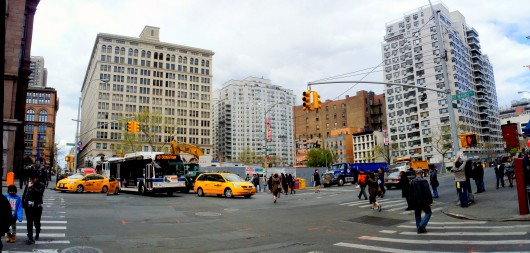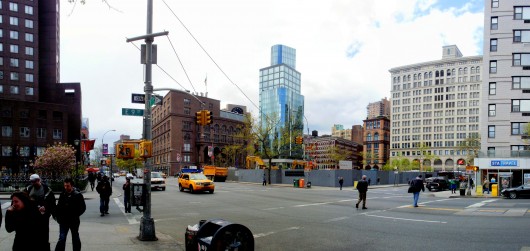A biweekly newsletter with public space news, resources, and opportunities.
A curated dispatch on all things public markets plus the latest announcements from the Market Cities Program.

In her 1958 essay "Downtown is for People," republished online by Fortune late last year, Jane Jacobs noted the presence of a Park Avenue block that had been razed in anticipation of an office building for which the developer was struggling to raise capital. Jacobs (who had been invited to write the essay by none other than Holly Whyte) called the site "New York's Mystery Plaza," noting wistfully that "in the meantime, sidewalk planners can design some wonderful plazas."
There's a similarly ephemeral and provocative moment that one can experience in New York right now, a bit further downtown. For the time being, the block bounded by Astor Place, East 9th Street, and 3rd and 4th Avenues is sans structure: once the site of Cooper Union's unassuming Engineering Building, is now home to a dirt pit and a couple of backhoes. The adjacent jumble of intersecting streets creates a number of thin triangular traffic islands that have long subbed in for a coordinated public space, with defiant success. In spite of the auto-centric planning so clearly on display, there are people here: coming and going, talking, performing.
This is a place where the buildings have never towered too tall, and the streets have never felt too narrow. And yet, the fact that there is additional open space feels even more pronounced here than it might in vertical Midtown, where the predominance of towers can camouflage absence.

The aforementioned dirt pit will be filled by a particularly egregious office block soon enough. Designed by Japanese architect Fumihiko Maki, it will feature an immense facade of dark glass that will glower over Astor Place, gobbling up more of the sky than its predecessor. But for the time being, there is a palpable sense of possibility here. The vaguely European 6-train entrance and Tony Rosenthal's accidentally iconic Alamo sculpture appear enhanced, now seeming like hints of a grand public square in the making, backed by so much blue sky.
The buildings surrounding the site are of varying heights and colors, and with their facades open and turned toward each other across the open block, they look as if they were always meant to be seen this way, like friends chatting around the table. Even the "Sculpture for Living" is less standoffish within the context of a larger urban tableau, reading more like a comedic foil to the dignified Wanamaker block, and less like a caged peacock.

Like Jacobs' original, this mystery plaza provides ample fodder for "sidewalk planners." Perhaps it is a side effect of the frenetic density of its surroundings, but the block almost demands that passers-by imagine an alternate use here. It feels as if the grid itself is saying "Do you see this? I clearly intended for this to be a square."
The mystery plaza at Astor Place will be gone soon. Long before Maki's "Death Star" is occupied, its frame will zip the space back up. But as the city moves forward with plans to pedestrianize some of the surrounding blocks to create a more deliberate public gathering place, let's hope that the sudden, bewitching openness created by the construction process inspires people to imagine not just what the site could have been, but how the adjacent spaces could better serve the people who use them--and to speak up. As Jacobs argued in Fortune, "planners and architects have a vital contribution to make, but the citizen has a more vital one. It is his city, after all."
The rich text element allows you to create and format headings, paragraphs, blockquotes, images, and video all in one place instead of having to add and format them individually. Just double-click and easily create content.
The rich text element allows you to create and format headings, paragraphs, blockquotes, images, and video all in one place instead of having to add and format them individually. Just double-click and easily create content.
Body Text Body Link
The rich text element allows you to create and format headings, paragraphs, blockquotes, images, and video all in one place instead of having to add and format them individually. Just double-click and easily create content.
Here is some highlighted text from the article.




Headings, paragraphs, blockquotes, figures, images, and figure captions can all be styled after a class is added to the rich text element using the "When inside of" nested selector system.
Headings, paragraphs, blockquotes, figures, images, and figure captions can all be styled after a class is added to the rich text element using the "When inside of" nested selector system.
Headings, paragraphs, blockquotes, figures, images, and figure captions can all be styled after a class is added to the rich text element using the "When inside of" nested selector system.